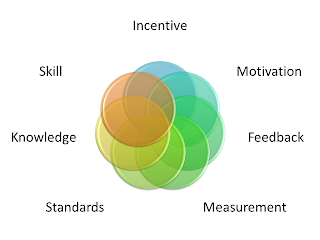ROI - The Process
 Back in 1999 The Jack Philips Center for Research coined the term "The ROI Process" (TM). It was, and still is, a comprehensive methodology for capturing ROI as well as the measurement of all aspects of the benefits of training (learning or performance) interventions. See The Four Evaluation Levels for Training Programs for additional insight. In The ROI Process there are five levels presented. ROI being a separate level from the traditional levels presented by Dr. Donald L. Kirkpatrick. Dr. Kirkpatrick included ROI in level four known as Results, because ROI is one of the measures of the final business results such as increased sales, reduced costs, etc. In my opinion, ROI is really a nice 'business' way to summarize your investment in the training intervention. However, common sense must be enlisted when, and if, you decide to establish the ROI of a learning event. The cost of determination can exceed the benefit! The organization that requests the learning event will need to take a major role in the benefit determination. They need to establish the justification and objectives of the intervention in terms of cost savings, labor utilization, faster call center response rates, customer satisfaction levels, higher process up-time, etc.
Back in 1999 The Jack Philips Center for Research coined the term "The ROI Process" (TM). It was, and still is, a comprehensive methodology for capturing ROI as well as the measurement of all aspects of the benefits of training (learning or performance) interventions. See The Four Evaluation Levels for Training Programs for additional insight. In The ROI Process there are five levels presented. ROI being a separate level from the traditional levels presented by Dr. Donald L. Kirkpatrick. Dr. Kirkpatrick included ROI in level four known as Results, because ROI is one of the measures of the final business results such as increased sales, reduced costs, etc. In my opinion, ROI is really a nice 'business' way to summarize your investment in the training intervention. However, common sense must be enlisted when, and if, you decide to establish the ROI of a learning event. The cost of determination can exceed the benefit! The organization that requests the learning event will need to take a major role in the benefit determination. They need to establish the justification and objectives of the intervention in terms of cost savings, labor utilization, faster call center response rates, customer satisfaction levels, higher process up-time, etc.A learning event can be an HR program, classroom training, virtual learning, e-learning, organization development, technical program, change initiatives, etc.
Now let's get back to The Process discussion. The process consists of eight major steps which can be grouped into four stages. These are defined by the The ROI Process diagram shown below which is similar to the one presented by the Jack Phillips Center for Research. The Four Stages are: (they are shown by different shading in the diagram)
- Planning
- Data Collection
- Data Analysis
- Reporting
- Develop the objectives of the learning event (requesting group) and/or Review the objectives of the learning event by the Training and Development Team.
- Develop evaluation plan (joint effort by requesting group and Training Team) and establish baseline data by the requesting group and reviewed by the Training Team.
- Collect data during the solution implementation, may be joint effort by both the requesting group and training team or performed by just the requesting group. This is the satisfaction/reaction and learning data points.
- Collect data after full implementation of the learning event/intervention. This is the business impact data.
- Separate and isolate the actual effects of the learning event/intervention from other factors that may have occurred simultaneously. Sometimes this will require interpretation of extraneous data and can also be subjective.
- Convert the data results to a monetary value. This is most likely done by the requesting group.
- Calculate the return on investment (ROI). Use the captured costs of the learning event/intervention and also identify any intangible measures/benefits of the event.
- Generate a formal impact study report presenting the information in executive briefing format and detailed backup as appropriate. Then formally present to your management board, if appropriate and possible.
 |
| The ROI Process for a Learning Event |
See also:
ROI - 1 - (Return on Investment) - The Calculation
ROI - 2 - Cost Benefit Analysis - COSTS
ROI - 3 - Cost Benefit Analysis - BENEFITS
ROI - 4 - The Four Evaluation Levels (Future)



Comments
Post a Comment